Top 10 Fascinating Facts about Cherry Barb Fish
Introduction
Cherry barb fish (“Puntius titteya“) are small, vibrant, and captivating freshwater fish that have captured the hearts of fishkeeping enthusiasts worldwide.
With their striking colors and peaceful nature, cherry barbs have become popular choices for community aquariums. In this article, we will explore the top 10 fascinating facts about cherry barb fish, shedding light on their behavior, care requirements, and unique characteristics.
Let’s dive into the enchanting world of cherry barbs!
Top 10 facts you should know about Cherry Barb fish
In this section, let’s talk about 10 different must-to-know and fascinating facts about the Cherry Barb fish. You can also have a clear idea about some of the important topics like Cherry Barb Care, Cherry Barb tank mates, and Cherry Barb temperature and water condition requirements through this section.
I guess you are ready to go through 10 different fascinating facts about the Cherry Barb fish. So let’s dive in right now.
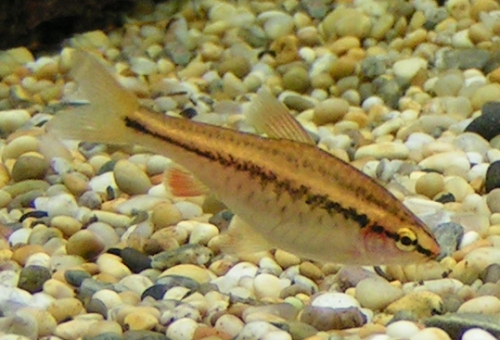
1. The Cherry Barb’s Color Transformation
One of the most remarkable features of cherry barb fish is their ability to change colors based on their mood and environment. Observing how their colors change can provide valuable insights into their mood and overall well-being.
When cherry barbs are happy and content, their vibrant colors shine, displaying shades of deep red, orange, and yellow. Conversely, when stressed or frightened, they can turn paler, adopting a lighter hue to blend in with their surroundings.
Understanding this color transformation can help fishkeepers gauge the well-being of their cherry barb community. In their natural habitat, cherry barbs inhabit clear and shallow waters with ample vegetation.
Their vibrant colors play a vital role in communication and social interactions within their community. Color transformation is a dynamic response to various stimuli, and understanding the underlying factors can help fishkeepers ensure the optimal health and happiness of their cherry barb fish.
Fishkeepers and enthusiasts can take delight in observing and interpreting these color shifts, as they offer valuable insights into the health and happiness of their cherry barb community.
2. Social Behavior and Shoaling for Cherry Barb Fish
Cherry barbs are highly social fish that thrive in the company of their own kind. They exhibit shoaling behavior, forming tight-knit groups that provide them with a sense of security.
Keeping cherry barbs in a small school of at least six individuals allows them to display their natural behaviors, resulting in a more active and lively aquarium.
Shoaling is a collective behavior exhibited by many fish species, including cherry barbs. It refers to the tendency of fish to swim together in tight-knit groups.
Shoaling serves various purposes, including safety, improved foraging, and enhanced communication. In the wild, cherry barbs form shoals as a defense mechanism against predators.
Swimming in groups makes it difficult for predators to single out an individual fish, increasing the chances of survival for the entire shoal.
Keeping cherry barb fish in a proper shoaling environment positively impacts their overall health and well-being. Inadequate social interaction or overcrowding can lead to stress-related issues, weakened immune systems, and behavioral problems.
Therefore, providing the appropriate number of cherry barbs in a community tank fosters a more natural and enriching environment, leading to healthier and more active fish.
3. Peaceful and Friendly Nature of Cherry Barb fish
One of the reasons why cherry barbs are highly sought after by beginner and experienced aquarists alike is their peaceful temperament.
Unlike aggressive fish species, cherry barbs are known for their friendly and non-confrontational behavior, making them excellent tank mates for other peaceful community fish.
Their gentle demeanor and ability to coexist harmoniously with other fish contribute to their reputation as ideal community tank inhabitants.
Cherry barbs are not known for aggressive tendencies. They are relatively peaceful and will rarely engage in aggressive behaviors towards tank mates. This non-aggressive nature makes them suitable companions for a wide variety of other peaceful community fish.
One of the key benefits of cherry barbs’ friendly disposition is their compatibility with a diverse range of fish species. They can comfortably coexist with other small, peaceful fish, such as tetras, rasboras, gouramis, corydoras catfish, and other similar-sized community fish.
When selecting tank mates for cherry barbs, it’s essential to consider their compatibility to ensure a tranquil and stress-free aquarium environment.
In a community setting, cherry barb fish typically focus on foraging, exploring their surroundings, and displaying their vibrant colors.
They rarely show aggressive territorial behavior, allowing other tank mates to occupy their preferred areas without conflict. Their friendly nature contributes to a serene and visually appealing aquarium environment.
4. Breeding and Courtship Rituals
Witnessing the courtship rituals and breeding behavior of cherry barb fish is a fascinating experience. During courtship, males display vibrant colors to attract females, engaging in elaborate dance-like movements.
Once a pair has bonded, the female lays adhesive eggs on submerged plants and the male fertilizes them. Learning about the breeding process can open up opportunities for fishkeepers to try their hand at breeding cherry barbs in a separate breeding tank.
Cherry barbs engage in courtship displays as a prelude to the breeding process. During courtship, the males exhibit vibrant colors, with their red and orange hues intensifying to impress the females.
The males often display by spreading their fins and performing dance-like movements in front of the females, showcasing their vitality and desirability.
During the courtship process, the females observe the courtship displays of the males. They may select a mate based on the male’s colors, movements, and overall vigor.
It is not uncommon for a female to choose the male with the most vibrant colors and the most appealing courtship behavior.
Once a pair has formed a bond, they will prepare for the spawning process. Cherry barb fish are egg-layers, meaning the female will lay adhesive eggs, which the male will fertilize externally.
To initiate spawning, the male will gently nudge the female, encouraging her to release her eggs. As she does so, the male simultaneously releases his sperm to fertilize the eggs.
5. A well know Hardy and Low-Maintenance Fish
For novice fishkeepers, cherry barb fish is a dream come true. They are hardy and can withstand a range of water conditions, making them forgiving of minor fluctuations.
Additionally, they are not demanding when it comes to diet and will readily accept a variety of foods, including high-quality flakes, pellets, and live or frozen treats.
Cherry barbs are exceptionally hardy fish, meaning they can tolerate a wide range of water conditions. They inhabit various water sources, including streams, ponds, and slow-moving rivers.
As a result, they have evolved to endure fluctuations in water temperature, pH levels, and hardness. This hardiness allows them to adapt to various aquarium setups and makes them forgiving of minor water parameter changes.
Cherry barb fish can thrive in water with a pH ranging from slightly acidic (around 6.0) to neutral (around 7.5). They can also tolerate a wide range of water hardness, from soft to moderately hard.
The ideal water temperature for cherry barbs is around 72°F, which falls within the standard range for many tropical community fish. Their ability to handle different water parameters with ease makes them adaptable to various setups, making them well-suited for beginner aquarists.
Cherry barbs are relatively small fish, typically reaching a maximum size of about 2 inches (5 centimeters) in length. This small size means they don’t require a large tank to thrive.
A 20-gallon aquarium is sufficient to house a small group of cherry barbs comfortably. Additionally, their peaceful nature allows for multiple fish to be kept together in a well-planted aquarium, creating a visually appealing and low-stress environment.
Cherry barb fish are omnivorous, this means that they eat a combination of plant-based and protein-rich foods. In the wild when they live in their natural environments, they feed on algae, small insects, crustaceans, and plant matter. But they readily accept a wide range of commercially available fish foods, including high-quality flakes and pellets.
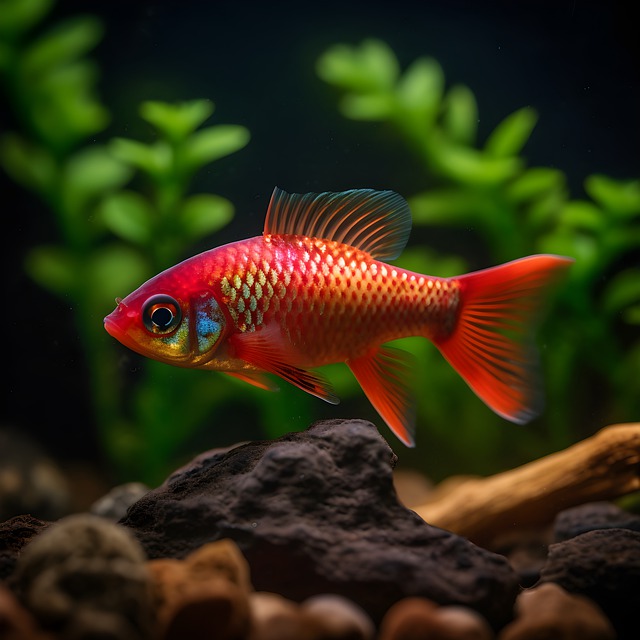
6. Suitable Tank Size and Setup for Cherry Barb fish
To ensure the well-being of cherry barbs, it is essential to provide them with an appropriately sized aquarium. A tank of at least 20 gallons (75 liters) is recommended for a small group of cherry barbs. Including live plants and creating hiding spots with driftwood or rocks replicates their natural habitat and makes them feel secure.
Cherry barb fish hail from densely vegetated streams and ponds. Recreate their natural environment by incorporating live aquatic plants into the aquarium.
Plants like Java ferns, Amazon swords, and Anubias not only enhance the aesthetics but also serve as shelter and breeding grounds for the cherry barbs. Plants create a sense of security, reducing stress and encouraging natural behaviors.
In their natural habitat, cherry barb fish inhabit slow-moving streams and rivers. Aim for a gentle water flow in the aquarium to replicate this environment. Adjust the flow rate of the filtration system to provide a comfortable and stress-free swimming experience for the cherry barbs.
7. Omnivorous Feeding Habits
Cherry barbs are omnivores, meaning they consume both plant-based and protein-rich foods. In a home aquarium, they enjoy a varied diet that includes high-quality flakes, pellets, freeze-dried or frozen foods, and occasional vegetable matter to keep them healthy and vibrant.
Cherry barb fish thrive on a varied diet that replicates their natural foraging behaviors. In their native habitats, these fish feast on a combination of plant matter, algae, small insects, crustaceans, and zooplankton. In the home aquarium, replicating this diverse diet contributes to their overall well-being and vibrancy.
Plant-based foods play a crucial role in the diet of cherry barbs. High-quality fish flakes and pellets specifically formulated for omnivorous fish serve as excellent staple food.
These foods usually contain a balanced mix of plant proteins, vitamins, and minerals that meet the nutritional requirements of the fish.
In addition to plant-based foods, cherry barbs eagerly accept protein-rich treats. Offer them live or frozen foods such as brine shrimp, daphnia, and bloodworms. These treats provide essential proteins and essential fatty acids, promoting growth, coloration, and reproductive health.
8. Lifespan and Longevity of Cherry Barb fish
Proper care, a balanced diet, and a stress-free environment can contribute to extending the longevity of any fish species. Learning about their lifespan helps fishkeepers make a long-term commitment to providing the best care for their Cherry Barb community.
Cherry barb fish have an average lifespan ranging from 4 to 6 years. This duration is influenced by various factors, including the quality of care they receive, the suitability of their environment, and their genetic disposition. Fishkeepers who provide optimal conditions and attentive care can significantly contribute to maximizing the lifespan of their cherry barbs.
Maintaining a well-maintained aquarium with stable water parameters, regular water changes, and efficient filtration ensures a healthy and stress-free environment will definitely help them to have a longer life span.
A balanced diet that includes a variety of high-quality foods rich in essential nutrients supports their overall well-being and extends their lifespan.
Avoiding sudden changes in water parameters, providing ample hiding spots, and avoiding aggressive tank mates promote a stress-free environment. Reducing stress helps prevent the weakening of the fish’s immune system and reduces the likelihood of disease and health complications.
9. Ideal Water Parameters
Maintaining suitable water parameters is crucial for the health and well-being of cherry barbs. They prefer water with a pH range of 6.0 to 7.5.
The temperature should be maintained between 72°F to 79°F (22°C to 26°C). Conducting regular water tests and performing routine water changes ensures optimal conditions for these captivating fish. Cherry barb fish are adaptable to a wide range of water hardness levels.
The ideal water hardness for them falls within a range of 5 to 20 dGH (degrees of General Hardness). Maintaining stable water hardness helps create a comfortable and stress-free environment for the fish.
Efficient filtration and aeration are essential for maintaining water quality in the cherry barb aquarium. A good quality filter helps remove waste and toxins, keeping the water clean and clear.
Adequate aeration ensures sufficient oxygen levels, supporting the fish’s respiratory functions and promoting their vitality.
Not just the filtration, monitoring ammonia, nitrite, and nitrate levels are crucial in preventing water quality issues. Ammonia and nitrite should always be at zero, as any detectable levels can be harmful to the fish.
Nitrate levels should be kept below 20 ppm (parts per million). Regular water changes of 25% every two weeks help keep these levels in check and promote a healthy environment for cherry barbs.
10. Compatibility with Tank Mates
When choosing tank mates for cherry barb fish, it’s important to select peaceful and non-aggressive species. Good companions include other small, peaceful community fish like tetras, rasboras, and dwarf gouramis.
Avoid keeping them with aggressive or fin-nipping fish, as this can cause stress and potential harm to the cherry barbs.
Cherry barbs are ideal companions for peaceful community fish due to their amiable temperament. They are known to interact well with other non-aggressive species, creating a serene and stress-free atmosphere in the aquarium.
When considering tank mates, choose other schooling fish such as tetras, rasboras, and danios, which share similar social behaviors.
While cherry barbs are peaceful, it’s essential to avoid introducing aggressive or territorial species to the tank. Aggressive fish may stress out the cherry barbs and disrupt their social interactions, leading to potential conflicts and health issues.
Selecting tank mates with similar water requirements is crucial for a thriving community aquarium. Fish that prefer similar temperature and pH ranges as cherry barbs are more likely to coexist harmoniously and remain healthy.
Cherry barb fish have delicate fins, making them susceptible to fin-nipping by certain species. Avoid housing them with fish known for nipping at fins, such as tiger barbs and some cichlid species. Instead, choose non-fin-nipping companions to maintain the cherry barbs’ beautiful appearance.
Conclusion
Bingo!!! you have reached the end of this aquarium article. Have you known these 10 fascinating facts about Cherry barb fish before? There are a lot of facts we can talk about this awesome freshwater fish species, and from all of them, those you have read are top 10 according to our selections.
Cherry barb fish are truly fascinating creatures that bring life and color to freshwater community aquariums. Their stunning colors, social behavior, and peaceful nature make them an ideal choice for beginners and experienced fishkeepers alike.
Understanding the unique characteristics and requirements of cherry barbs enhances the joy of fishkeeping and ensures a thriving and harmonious aquatic environment.
By providing them with proper care and a suitable community, you can enjoy the beauty and charm of these captivating fish for many years to come.

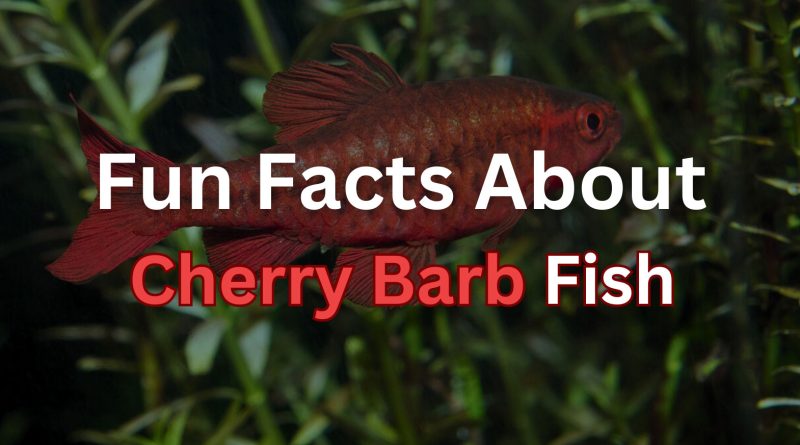
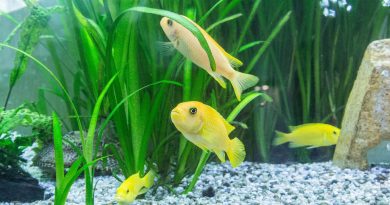
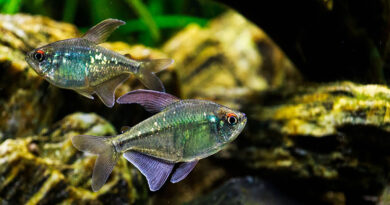
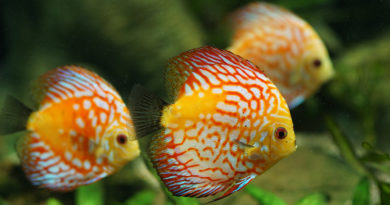
Pingback:Best Betta fish tank mates in 10 gallon - www.aquariumfreaks.com